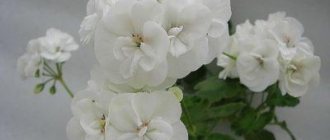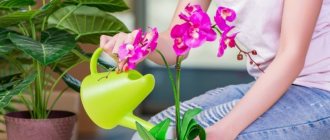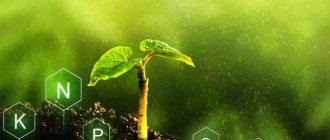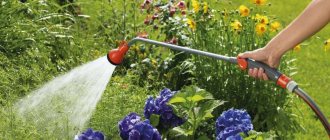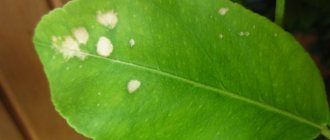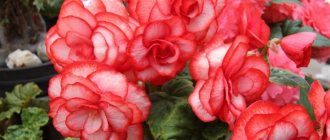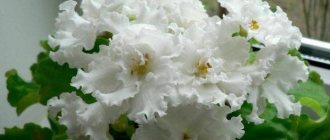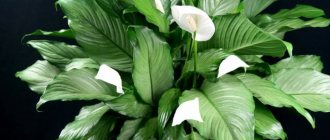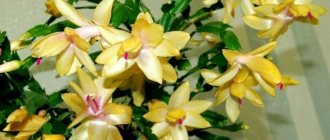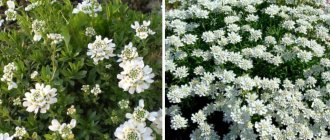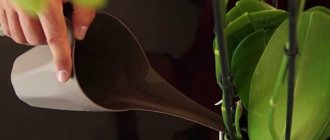Why is it important to feed on time?
It is necessary to provide nutrition for hydrangea throughout the entire period of spring and summer.
The plant also needs nutrition to restore its strength to generate buds for the next season. If you do not add nutrients, the hydrangea will bloom less often, and the color of its buds will not be so bright. In July, before the flowering of paniculate and tree hydrangea, substances identical in composition are used, since these two varieties have the same nutritional preferences. This period is the most crucial. If you do not apply the necessary fertilizers, the buds will be small and will not last long on the stem.
WHAT YOU NEED TO REMEMBER WHEN CARING FOR HYDRANGEAS
In the central and northern regions of Russia, only three types of hydrangea are grown: tree-like, paniculate and large-leaved. Some gardeners successfully cultivate less winter-hardy oakleaf hydrangea in their garden.
These hydrangeas differ from each other in appearance, flower color, and frost resistance. They are formed and prepared for winter in different ways.
Otherwise, caring for them in the summer-autumn period is almost the same.
It should be remembered that the root system of all hydrangeas is located in the top layer of soil, so when hilling and loosening you should be very careful not to damage its roots, which come close to the surface of the earth.
The end of July and August can sometimes be very hot, so plants should be shaded during the midday hours, otherwise they will lose their decorative effect. We have already written that hydrangea should initially be planted in a partially shaded area.
Features of the fertilizer
in spring
If you properly fertilize a flower, it will have a bright, beautiful leaf plate and abundant flowering throughout the season.
The first spring feeding is necessary for the formation of healthy and strong leaves. It should be carried out in March, as soon as sap flow begins. During this period use:
- Nitrogen preparations. You can use a mixture consisting of urea and potassium sulfate (20 g per bucket of water). For 1 bush, 5 liters of solution is enough.
- Organic matter , for example, slurry.
- Phosphorus and potassium. These minerals must be introduced before flowering. For 10 liters there is 1 tbsp. substances.
- Potassium permanganate. You need to spray the leaves of the bush with a weak solution (3 times in the spring). Then the plant will be strong and flexible.
In summer
- In June, a solution of nitrophoska and Agricole is needed (20 g per bucket of water). Organic doesn't hurt either. Under each plant you can pour 10 liters of diluted nettle infusion.
- In mid-July, the flower needs to be fed so that the inflorescences actively bloom and bloom for a long time. Store-bought drugs are suitable, for example, Kemira flower. For 10 liters of water there is 1 tbsp.
- In August, you can use mineral fertilizers, alternating with organic ones.
in autumn
Autumn fertilizing is necessary to prepare the crop for the dormant period and the formation of young shoots with flower stalks. Potassium-phosphorus compounds are used.
Potassium makes the plant's root system stronger and helps it survive the cold winter.
With the onset of autumn, the plant needs organic matter, for example:
- peat;
- compost;
- humus.
Spread the fertilizer near the bush in a layer of 5-10 cm. Then the soil will not freeze in winter, and the root system will be protected.
Why do you need spring and summer feeding of hydrangea: the benefits of the procedure
A lack of nutrients in the soil generally has an adverse effect on the shrub: it grows worse, the flowering is less lush, shorter and less beautiful, it is more susceptible to pests and diseases, and is vulnerable to unfavorable environmental conditions (heat, frost, temperature changes, strong winds and etc.).
On nutrient-poor soil it is unlikely to see beautiful and luxurious flowering.
The shrub needs complex nutrition, which consists of macroelements (nitrogen, phosphorus, potassium) and microelements (iron, boron, copper, magnesium, sulfur, manganese, zinc).
- Nitrogen is necessary for intensive growth of strong shoots and leaves (that is, for increasing green mass in the spring).
Important! You should be careful with nitrogen fertilizing, because the abundance of this macroelement will cause too intense growth of green mass, which will affect flowering (make it not so bright and saturated).
- Phosphorus is the most important element for shrubs; it is required for lush and long-lasting flowering and affects the number and size of flower buds. In addition, thanks to phosphorus, a strong and healthy root system that is resistant to frost develops.
- Potassium plays the same important role as phosphorus; when added in the spring, it contributes positively to flowering this season; in the autumn, it helps to lay flower buds for the next season, and is also necessary for a successful winter.
- Micronutrients are also important for the well-being of the perennial. Iron is of particular importance (since the plant is susceptible to chlorosis, and if the element is deficient, it is more vulnerable to disease). Also, for example, magnesium affects the setting of buds and the saturation of inflorescences.
It turns out that fertilizing is necessary for hydrangeas (both paniculata, tree-like, and large-leaved) for a successful growing season. The care procedure helps the flowering shrub to safely grow green mass (growth of stems, leaves), bloom magnificently, beautifully and for a long time (makes the inflorescences brighter, larger, more saturated). The bush also becomes more resistant to various weather conditions, stress, diseases and pests.
What types of fertilizers are there?
Nitrogen
Used in early spring, immediately after the snow melts. But nitrogen must be applied carefully. If you exceed the dosage, the foliage will begin to grow actively, but the flowering will not be bright and long-lasting. The following fertilizers are suitable:
- Urea - 10-15 g of substance per bucket of water.
- Ammonium nitrate - 15-20 g of the drug per bucket of water.
- Ammonium sulfate - it is placed in the ground in a layer of 5 cm.
Complex mineral
In spring, the following substances are used:
- Nitroammophoska. Dissolve the drug (20-30 g) in a bucket of water. 1 adult plant requires 5 liters of solution.
- Diammfoska – dosage per bucket is 30 g (after flowering).
- Potassium monophosphate - dosage 10-15 g of the drug.
The above fertilizers do not contain microelements, so it is recommended to add humates to the prepared solution.
Phosphorus-potassium
Lack of phosphates negatively affects metabolic processes. You can tell the deficiency by the presence of blue leaves.
You need to use phosphorus-potassium fertilizing once a season. These substances dissolve gradually and do not penetrate deeper into the soil.
With humates and microelements
Humates are suitable, which will allow mineral fertilizers to be better absorbed. You can take Potassium Humate as a basis and add complex mineral fertilizer to it (take in equal proportions).
Unusual means
Interesting top dressing:
- Kefir. 2 liters and 10 liters of water are enough. Necessary for watering hydrangeas.
- Yeast infusion. Dosage 3 tsp. sugar and 10 g of dry yeast per bucket of water. One plant will require 5 liters of product.
- A weak solution of potassium permanganate (should be slightly pink). The shoots will be strong and the buds will be large.
Ready-made special formulations
To feed the flower, you can use purchased ready-made preparations (dosage per 10 liters of water):
- Fertika Kristalon – 1 tsp.
- Agricola “For hydrangeas” – 15 ml of the drug. 1 plant will require 5-7 liters.
- Bona Forte “Fertilizer for blue hydrangeas” – 80 ml. Consumption – 10 l per 5 m2 of planting.
To acidify the soil
For luxurious flowering of hydrangea and protection from chlorosis, the soil should always be acidic.
To do this, it needs to be acidified periodically - once a month during flowering. The following solutions are suitable for these purposes (dosage per 10 liters of water):
- Slightly acidic electrolyte solution – 10 ml of the drug.
- Apple cider vinegar – 100 ml.
- Citric acid – 20-40 g.
It is advisable to add iron chelate (20-30 g per 10 l) to the solutions prepared above.
Folk remedies
The following home remedies are effective for feeding the flower:
- Cow dung. Dissolve it in water in a ratio of 1:10. Wait 14 days, stir the mixture periodically. After this, dilute the infusion with another 10 liters of water. Pour the resulting solution onto the bush at the root. If cow manure is not available, then horse or rabbit manure will do. After 2-3 days the treatment can be repeated.
- Serum. Dilute 1 liter of fermented milk product in 10 liters of water. Water the plant at the root with the resulting solution.
- Black bread. It contains yeast, which has a positive effect on the plant itself and the soil. Infuse a loaf of bread in 10 liters of water for 2-3 days. Send the filtered solution to the root of the bush.
To change the color of a flowering plant
You can regulate the color of hydrangea flowers by changing the acidity of the soil. The more acidic it is, the more saturated the color (purple or blue). You can get pink or crimson flowers if you grow the bush in soil with an acidity of 6-6.2 pH.
To reduce acidity, deoxidizers are needed:
- dolomite flour;
- lime;
- wood ash;
- fluffy.
And to get blue flowers from pink flowers, you can prepare a solution of potassium alum (30 g per 10 liters of water). One bush will take 2-3 liters.
What to water with
Many experts note that hydrangeas should be watered with rainwater. But this statement applies more to varieties grown in open ground. But for indoor plants you should use settled water. Do not water with cold water. It is best to use settled water at room temperature so as not to shock the flower.
So, in terms of watering, this type of indoor plant has the following rules:
- Soft water is used for irrigation. If rainwater is not available, then simply boil tap water. You can just defend it well;
- The water temperature should not be too cold or warm. An excellent option is at room temperature.
It is also worth noting that by changing the characteristics of water for irrigation, it is possible to change the color of the buds. For example, this way you can get pink or blue inflorescences. Most often, flower growers strive to obtain blue buds. To do this, there must be aluminum in the soil, and in a form accessible to the plant. Such conditions are possible if there is an acidic reaction in the soil (pH not lower than 5.5).
In this case, additional introduction of the element itself is necessary. It can be added with water as aluminum sulfate (15 g/l). This substance must be added to the water throughout the growing season. Potassium salts can often be used instead of aluminum sulfate. To achieve the desired result, you need to slightly moisten the soil with ordinary clean water before watering. Using different substances in watering, you can achieve flowering with pink buds.
Adding nutrients to different types of shrubs
Paniculata
For this variety of hydrangea, complex mineral fertilizers from the following manufacturers are suitable:
- Fertika. During 2 weeks of the growing season, you need to apply liquid fertilizer. This is a long-acting fertilizer. It must be scattered near the bush, mixed with soil, and then watered with water.
- Green World. This drug is used for active flowering. You need to apply 1-2 times per season. A nutrient mixture consisting of nitrogen, potassium, magnesium and phosphorus. Contains nitrogen, aluminum and potassium oxide, which increase the vitality of the crop.
large-leaved
For this plant, fertilizing must be done in several stages:
- Early in the spring. Add a nutrient mixture consisting of nitrogen, phosphorus and potassium to the root part. This will activate the formation of shoots and improve leaf growth. You can use purchased complex fertilizers for hydrangeas.
- During the formation of buds. Apply only potassium-phosphorus compounds. After 2 weeks, feed the plant again.
Treelike
This plant is tall (up to 1.5 m). So nutrition for the full growth of tree hydrangea is simply necessary. Fertilizing needs to be done in several stages:
- Early in the spring. Kemira flower required. It can be applied dry or as an aqueous solution.
- The period of bud formation. Superphosphate and potassium sulfate (50 and 25 g) are used.
During flowering of the plant, the shoots need to be treated with potassium permanganate.
Description of hydrangea
Hydrangea, or as it is also called Hydragea, is a flowering plant belonging to the Hydrangeaceae family. Although some gardeners classify it as a member of the Saxifraga family. It is worth noting that sometimes flower growers use the name hydrangea to mean representatives of the genus Schizophragma.
Today this flower has approximately 35-80 species. In the wild, hydrangea is distributed throughout East and South Asia, as well as South and North America. However, the greatest diversity is found in East Asia (Japan and China). Due to the specific nature of its growth, this wonderful flower appeared in Europe only at the end of the 19th century. The varieties brought from Japan were first used only as indoor plants, and only after the start of breeding did hydrangea begin to be grown in gardens. As a result of selection, many varieties have appeared that have become widespread throughout the world.
Many representatives of the hydrangea variety are shrubs and can reach 1-3 meters in height. This plant can have the appearance of a tree that grows up to 30 meters in height. Some varieties are vines that climb tree trunks in the wild. Representatives of the hydrangea genus are both evergreen and deciduous. In the temperate zone, mainly deciduous species are found.
Hydrangea has many varieties that are grown at home today. Growing in a pot, the flower is a shrub whose height varies widely from 50 cm to 1.5 meters. The flower forms spreading and erect bushes. Large falling leaves form on the stems. Inflorescences are spherical or wide pyramidal in shape. Moreover, their diameter can exceed 15 cm.
As a houseplant, this flower blooms for a fairly long period of time (from spring to late autumn). The colors of the buds depend on the type of plant. All flowers have a similar type of flowering - spherical inflorescences, which are collected according to the type of panicle and shield. The vast majority of representatives of the hydrangea variety have two types of flowers:
- small fertile and fruiting flowers. They are located in the middle;
- large sterile and sterile flowers, which are concentrated at the edges.
Moreover, some plants have only fertile flowers of the same size. Often the color of the inflorescences of this indoor flower is white. But some representatives of the variety, such as large-leaved hydrangea, can produce flowers of blue, red, lilac and pink. To get these colors you need to slightly change the care of the plant. The color of the inflorescences largely depends on the soil pH (pH):
- in acidic soils, hydrangea inflorescences will be blue;
- on neutral soils - the color of the inflorescences will be pale beige;
- in an alkaline environment, the color of the flowers will turn lilac or pink.
After the completion of the flowering period, a fruit is formed on the plant, which looks like a 2-5-part capsule with a large number of small seeds. Indoor hydrangea can be called an unpretentious plant, the care of which comes down to the following important aspects:
- temperature regime. Care includes exclusion from high temperature conditions. In winter, care involves creating a temperature range of 10-12°C;
- frequent watering. This is a moisture-loving plant that requires most of its care;
- requires frequent watering.
If the hydrangea is cared for correctly, the plant will delight you with the beauty of its inflorescences (the color will be rich) and health. You can achieve this thanks to encyclopedic information about hydrangea
Watering
How often is it done?
The norm is 50 liters 2 times a week. If natural precipitation occurs and the soil is deeply saturated with rainwater, then there is no need for additional moisture.
Mulch will help reduce the frequency of watering. Mulched bushes are moistened once every 7-10 days.
How and what to water?
Hydrangea is a capricious plant, so it has its own requirements for watering:
- It is forbidden to use hard water, as it can affect the acidity of the soil. Soft and warm water is best.
- You can add 2-3 g of potassium permanganate to the water. This will prevent the development of rot.
- Water the bush in the morning or evening.
- After each moistening, loosen the soil to a depth of 5-6 cm.
How to properly fertilize hydrangeas in spring and summer
Any garden procedure for caring for any crops is useful only if done correctly. Improper implementation of the activity, in particular, fertilizing, can cause adverse consequences. At best, you simply won’t see any effect; at worst, the plant will suffer (from stress and poor flowering to severe weakening, and even death).
In order for this procedure to bring maximum benefit (without a hint of harm) in spring and summer, it is recommended to adhere to the following rules:
- There are 2 ways to apply fertilizers: Root feeding - nutrients are applied under the roots into the soil around the plant. It is most effective to apply a liquid fertilizer solution (it acts faster). However, with this method, dry matter can also be incorporated into the soil (it gradually nourishes the perennial when dissolved during watering and rain).
- Foliar (that is, spraying the above-ground mass) is an auxiliary procedure for the first method, most often used to introduce microelements.
- One of the most important rules of this care procedure: a couple of hours before feeding, you need to water the bush with plain water ! If this is not done, the root system may get burned.
- When using any fertilizers, you must carefully study the instructions for each preparation! It is important to follow all manufacturer's recommendations and use the recommended dosage and dosage.
- If, when planting a seedling in open ground, you added enough fertilizer (that is, you filled the planting hole well), then you do not need to feed it for the first 2 years after planting!
- Root feeding (liquid or dry granules) needs to be done at a short distance from the trunk (optimally 15-20 centimeters). Avoid applying substances directly under the trunk!
- A convenient way to add nutrients to the root: make small holes or one furrow around the bush, retreating 15 centimeters from the trunk. The depth of the groove/holes is about 5 cm. And pour the solution into this depression (or put dry matter), and then back cover it with earth.
- The optimal time of day for the procedure: early in the morning or evening , when the sun has set. It is allowed to carry out gardening activities during the day, but only in cloudy weather, when the sun is not expected to come out from behind the clouds! It is impossible to carry out root and especially (!) foliar feeding of hydrangea in sunny weather at midday. The plant can get burnt on leaves and shoots (when sprayed) and become severely stressed.
- You need to pour the liquid solution carefully. So that the liquid does not fall on the above-ground part (leaves, stem). After all, when applied by roots, the concentration of substances is higher than when sprayed, so the perennial can get burned. If the solution gets on the leaves or stem, then you need to immediately rinse the area with clean water (for example, spill it from a watering can).
How and what is the best way to feed after flowering?
In August, the plant already needs to be prepared for winter. Phosphorus-potassium fertilizer will help with this. It needs to be applied in the second half of September, before frost comes.
To obtain a solution, you need to dissolve 2 tbsp. superphosphate and 20 g of potassium sulfate. 1 plant requires 10 liters of solution.
After 2-3 days, the surface of the soil in the tree trunk circle needs to be covered, a layer of mulch should be laid from:
- peat;
- pine shavings;
- humus.
This will insulate the roots and give them additional nutrition.
When to feed hydrangeas in spring and summer
The timing of the procedure directly affects the feeding scheme. It is very important to adhere to certain time periods, because this directly affects the effectiveness of the event. When is the best time to feed hydrangeas in spring and summer? It is optimal to do this several times in the following periods:
- First feeding (early spring). It is carried out after the plant begins to awaken after wintering (when the snow melts and the first green shoots begin to grow). In this case, the soil should warm up to 5-10 degrees Celsius (at a lower temperature, the perennial will not be able to absorb nutrients). Nitrogen fertilizers must be applied in early spring. However, it will be better if, in addition to nitrogen, you also add phosphorus and potassium!
- Second feeding (during budding). This time, replenishment should be applied during the formation of buds (before they bloom!). It is very important because... stimulates lush flowering of hydrangea. Plenty of phosphorus and potassium should be added, as well as a small amount of nitrogen.
- Third feeding (during flowering). This procedure is optional, it is not as important as the second. It should be done at will. During this period, potassium and phosphorus are added (without nitrogen!), as well as microelements.
- Last feeding (late summer or autumn). Hydrangea should be fertilized for the last time at the end of August or September. The procedure at this time is necessary to prepare the shrub for wintering, so that the perennial can lay new flower buds for the next season. Phosphorus-potassium fertilizers are applied.
Note! What specific fertilizers to apply in each period will be discussed below.
Timing of the procedure according to the Lunar calendar 2022
A good guide when choosing the timing for fertilizing can be the cycles of the moon. According to the Lunar calendar of 2022, the following favorable days can be identified for applying fertilizers to hydrangeas:
- in March: 8, 9, 10, 11, 19, 20, 21, 22, 25, 26, 27;
- in April: 5, 6, 7, 8, 9, 18, 19, 20, 21, 22, 23, 26, 27;
- in May: 6, 7, 8, 9, 10, 19, 20, 21, 22, 23;
- in June: 3, 4, 5, 6, 8, 9, 10, 20, 21, 22, 23, 24;
- in July: 6, 7, 8, 9, 18, 20, 23, 24, 25;
- in August: 7, 8, 9, 18, 19, 20, 21, 24, 30;
- in September: 3, 4, 5, 6, 7, 19, 20, 21, 22, 23, 29;
- in October: 3, 4, 5, 6, 7, 18, 19, 20, 21, 22, 30, 31.
What to do if the leaf blades turn yellow?
If yellowing of the platinum sheet is observed, then you need to find out the cause of this phenomenon and eliminate it:
- Drafts. A secluded place in an area where there are no gusts of wind is suitable for the flower. It is best to use areas along the house or fence for planting.
- Lack or excess of moisture, light. The plant must be planted in a slightly dark place. You also need to make sure that the soil does not dry out, otherwise the foliage will not only begin to turn yellow, but also fall off.
- Lack of nutrition. Before planting the tree, you need to add 10 kg of rotted manure into the planting hole.
- Powdery mildew. This is a fungal disease, to combat which you need to remove all affected areas of the hydrangea.
Color changing technology, step-by-step diagrams and instructions
The first thing you need to do in the procedure for changing the shade of inflorescences is to find out the degree of acidity of the earth. To do this, you need to use special chemicals or turn to “grandmother’s” methods for help.
Step by step diagram
- Determine the acidity of the soil.
- We select different preparations for different colors.
- We water it with a solution or add dry preparations, but be sure to incorporate it into the soil.
Application of drugs
You can change the composition of the earth and make it less or more acidic using chemicals.
There are two different effective and inexpensive methods.
The first is to use acidic peat during the planting process (coniferous peat is perfect). The second is to feed with fertilizers that oxidize the soil.
To make an area less acidic, it is necessary to add additives to make it neutral. The following mineral fertilizers are suitable for this:
- Dolomite flour.
- Limestone.
- Calcite.
- Chalk.
What are the dangers of nutritional deficiency and excess?
When there is a lack of nutrients, the following phenomena are observed:
- Leaf chlorosis. They become light yellow and pale. To save the plant, you need to water it once every 10 days with a solution of iron-containing salts. You can dissolve 6 g of iron sulfate in a bucket of water.
- Dark spots on leaves during flowering. This symptom indicates a lack of potassium.
If you apply fertilizer in excess, this is fraught with the following consequences:
- Excess nitrogen - the plant will not be able to fully prepare, and its frost resistance decreases. Freezing of the buds in winter will negatively affect flowering.
- Oversaturation with fertilizers with inadequate watering increases the salt content in the soil. Because of this, young roots suffer.
- Potassium oversaturation contributes to premature yellowing of the leaf blade and deterioration of the color of the buds.
- An increased concentration of phosphorus will lead to poor absorption of iron, zinc and other trace elements by the plant. The flower becomes sensitive to lack of light.
How does watering affect a plant?
The shade of hydrangea depends on the aluminum content in the soil where the shrub grows . The element reacts chemically with the dye in the petals and changes their color. On soils rich in this element, the plant has blue, blue or purple inflorescences; on poor clay soils they turn pink. This factor only affects varieties with colored buds, such as hydrangea macrophylla. Varieties with snow-white flowers do not change under the influence of acidic substances.
Important! Before starting to acidify the soil in the garden, the owner of the estate should determine its pH to make sure that the procedure is really necessary.
Errors when leaving
Experienced gardeners were able to identify common mistakes in caring for hydrangeas:
- If a flower is overfed with nitrogen, it will not have time to harden by winter, which is why it will not tolerate frost well.
- Tap water is prohibited for watering the plant, as it will contain a lot of chlorine. It is this that is a common cause of leaf chlorosis.
- Do not use stagnant water, which can lead to rotting of the root system.
- Watering should not be done during the day, and drops of water should not fall on the flowers, otherwise it will cause a burn.
It is necessary to fertilize hydrangea throughout the growing season. Feeding should be used rationally and in accordance with the schedule. Excess or deficiency of nutrition can lead to various consequences, as well as the death of the flower.
How to water
Being a very moisture-loving plant, hydrangea requires frequent and abundant watering in its care. Summer care involves the most regular watering. Indoor hydrangeas need to be watered at least twice a week. If you pour a little peat into the top of the pot, this will reduce moisture loss and allow you to water a little less often.
In spring or autumn, care needs to be changed slightly. At this time, indoor hydrangea should be watered moderately. And in winter, you need to constantly monitor the absorption of moisture by the soil, since at this time you can easily flood the flower and its roots will begin to rot.
You need to water the flower when the soil dries out. In this case, care involves avoiding the formation of an earthen crust. Watering should be done in the evening and morning. This is due to the fact that direct sunlight has a detrimental effect on the well-being of hydrangeas. Flower growers also note that care in terms of watering should not be excessive, otherwise flooding the flower will create a kind of shock for it.
In what cases can you not change the color?
There are situations when changing the color of a plant, even with a strong desire, will not work. In such cases, natural limitations interfere:
- Any white varieties of hydrangea, with a high degree of probability, will not change the color of their inflorescences to blue or pink. In rare cases, white hydrangea may change color to slightly pinkish with age, but this is not a fact. It will not be possible to have any effect on color change using complex liquid additives;
- It is impossible to change the brightness of the color of hydrangea;
- If hydrangeas are planted in an area with a hot climate, you will never see buds of rich, bright color. Otherwise, they will simply die.
